Table of Contents
ToggleIntroduction
Welcome to the world of data science! Learning the fundamentals of data science is essential for those who want to use this rapidly growing field. With the demand for data-driven decision-making, understanding and leveraging data science principles has become increasingly crucial for both freshers and professionals.
In this blog, we will present an introduction to the data science subjects or syllabus. We will discuss the various topics covered and which data science subjects can help you master the basics of data science.
The basic topics covered in typical data science subjects include programming languages such as Python, R and SQL, statistics concepts such as probability distributions and linear regression, software engineering best practices, databases, machine learning algorithms and software engineering frameworks such as Hadoop. This list may vary depending on the type of course or training program you attend.
For freshers seeking to gain foundational data science knowledge, we suggest first starting by studying Python or R programming language. A basic understanding of these programming languages will be essential for further learning in the field. Additionally, those looking for a more comprehensive study should also familiarize themselves with databases such as PostgreSQL or MongoDB and software engineering best practices.
Finally, machine learning concepts such as neural networks, deep learning architectures and reinforcement learning are fundamental to understand if one wishes to become an expert in the field.
For professionals already working with data but seeking to advance their knowledge base, we suggest studying concepts related to extensive data management, such as Hadoop or Spark frameworks. Additionally, focusing on streaming technologies such as MapReduce provide valuable skills that will aid in managing large volumes of data effectively.
Importance of Statistics and Probability as Data Science Subjects
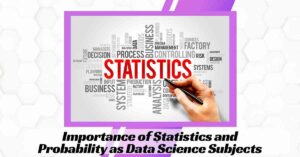
It is definitely an important part of Data Science Subjects. From basic statistics and probability to complex business forecasting, there are several data science subjects that you should become familiar with. Whether you’re a fresher or a professional, understanding these topics is key to getting ahead in the field.
To get started, let’s look at the basics of statistics and probability. Introductory courses typically cover data science subjects like descriptive statistics, which involve summarizing large amounts of data in graphs and tables. From there, sampling and data distribution will be discussed — this involves selecting samples from different groups and then looking at how certain statistical properties vary across them.
Following those topics is a discussion on probability theory and models. This includes the fundamentals of chance, as well as Bayesian probabilities. Students may also cover hypothesis testing — a branch of statistics used to make decisions based on evidence from experiments or observations. Hypothesis testing can be used for anything from medical studies to product development.
Next up is correlation analysis — which is used to identify relationships between two or more variables. It can give you insights into how these variables affect each other and can help inform decision-making regarding strategies or policies related to them. Regression analysis is another important topic in data science — it helps bring together the concepts of correlation analysis by looking for trends between variables that indicate cause-and-effect relationships.
Finally, business forecasting allows you to use predictive analytics techniques like machine learning to gain insight into future outcomes like customer behaviour or market trends. This can be an invaluable tool for businesses of all sizes when planning strategic operations or financial investments far into the future.
Exploratory Data Analysis and Visualization
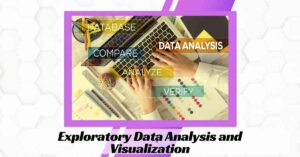
Exploratory Data Analysis (EDA) and Visualization are two important aspects of Data Science Subjects, and it is critical for understanding what’s going on in your data. EDA involves exploring, analyzing and visualizing the datasets by looking at the size, shape, distribution, summary statistics and relationships between variables. By exploring data in this way, it is possible to identify patterns and gain insight that can be used to make decisions or predictions.
Visualization techniques are a valuable way to present various types of information visually appealingly. Visualizations can quickly summarize trends in your data and help you spot potential problems. With powerful visualization tools available today, creating stunning graphics that help you interpret complex datasets is easy.
Data mining is discovering interesting, previously unknown patterns from large datasets using machine learning algorithms. Data mining techniques allow us to uncover hidden relationships between variables by exploring correlations within the data. Common data mining examples include clustering, association rule learning and anomaly detection.
Univariate and multivariate analysis is another set of techniques for better understanding datasets. The univariate analysis looks at one variable at a time, while multivariate looks at multiple variables together. The univariate analysis will give you an overview of each variable while multivariate allows you to see how those variables interact.
Machine Learning Algorithms
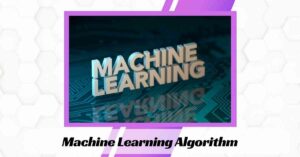
Data Science is a rapidly growing field and requires a strong understanding of Machine Learning algorithms. Knowing how to deploy and use Machine Learning algorithms as Data Science Subjects is an essential skill for data scientists. Various Machine Learning Algorithms, such as Supervised and Unsupervised learning, Neural Networks, Regression/Classification, Hyperparameters Tuning, Data Cleaning/Preprocessing and Model Evaluation, are used today.
Supervised learning uses labelled data to train the machine learning model with inputs and outputs. It helps in predicting outcomes by generalizing the historical data. Unsupervised learning, however, uses unlabeled data so that the model can find underlying patterns without being provided with labels or error signals.
Neural networks can be thought of as building blocks of several machine learning algorithms used for regression and classification problems. A neural network comprises a set of interconnected processing elements (nodes), each receiving one or more inputs from external sources and producing one or more outputs. Similarly, a deep learning neural network receives inputs from external sources and produces sequential outputs that form the basis of the neural network’s predictions.
Regression analysis is a statistical approach used to understand relationships between input (independent) and output (dependent) variables to predict outcomes accurately. In contrast, classification algorithms group data int
o distinct categories or classes based on their characteristics. Regression and classification algorithms require rigorous preprocessing before being effectively deployed in a live machine-learning application. This includes transforming raw data into its numerical form to be processed by an algorithm and hyperparameter tuning, which involves adjusting parameters such as weights, learning rates, etc., for optimal results.
Big Data Technologies as Data Science Subjects
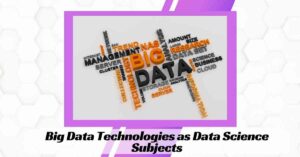
Big Data technologies are powering the modern world, and we’re only just beginning to scratch the surface of their potential. As we learn to leverage this powerful tool more and more, it’s becoming increasingly important to stay updated on the latest advancements. One way to do this is to dive into data science subjects that can give you a comprehensive overview of big data, how it works, and practical methods.
For freshers looking to tap into this burgeoning field, Data Science Subjects like statistics, machine learning, and programming basics are excellent starting points. Understanding big data will become easier as you learn the fundamentals such as descriptive and inferential statistics, supervised and unsupervised learning algorithms, basic coding skills in Python or R (or both), etc. With a few key concepts, you can start building a foundation for working with large datasets and evolving your knowledge further.
For professionals already immersed in data analytics methods, taking the time to review core concepts can be an invaluable exercise. Extensive data courses should cover topics like advanced statistical models for forecasting and optimization of business outcomes based on current trends, software development best practices that ensure your code is accurate, artificial intelligence (AI)
Methods such as natural language processing (NLP) that harness the power of machine learning algorithms to make sense of unstructured text; real-time analytics capabilities that allow us to make decisions quickly; visualization techniques for making complex information easier to digest; plus more depending on your field of focus such as healthcare analytics or web development.
By having a deeper understanding of these other related contexts, your skillset will become better rounded – enabling you to bring even more value as you work with large datasets.
Know About: best data science courses in india
Natural Language Processing in Data Science Subjects
NLP covers various topics, from text analysis and tokenization to text classification and machine translation. Understanding these concepts can be difficult for beginners, but with some background knowledge and experience, you can confidently use NLP in your data science projects.
Text Analysis is the process of analyzing text to extract meaning from it. Understanding the structure, syntax, and semantics of the written language makes it possible to understand the intent behind a text and draw conclusions from it. This is especially useful when searching large amounts of data for specific keywords or phrases related to a particular outcome.
NLP applications span many industries and disciplines. For example, one might use NLP when creating marketing campaigns or analyzing customer feedback on social media platforms. It can also be helpful when trying to discover trends or find targeted solutions for customer service issues. Companies can create more effective strategies that better serve their customers by understanding how language is used in any context.
Tokenization is a vital part of any NLP process. This involves breaking up strings of words into individual pieces called “tokens”, which can then be processed further by other algorithms or programs. PartofSpeech tagging is another critical concept that assigns labels such as “verb” or “noun” to each token so that relationships between words can be better understood. On top of this, Named Entity Recognition (NER) allows for deeper analysis by recognizing entities such as people’s names or dates within text sentences.
Deep Learning Networks used as Data Science Subjects
Deep Learning Networks are a part of Data Science Subjects that is becoming increasingly popular as AI and machine learning become more prevalent. Deep Learning Networks are the branch of artificial intelligence (AI) focused on creating machines that can autonomously learn from massive amounts of data. This type of network contains many layers, which help them to identify patterns and accurately make decisions. Some common applications for deep learning networks include image processing and recognition, natural language processing, time series analysis, recommender systems and computer vision.
If you are starting with Data Science Subjects like Deep Learning Networks, Indeed, It is an excellent topic to cover. You will need to understand the basics of Machine Learning models, such as supervised and unsupervised learning algorithms and their use cases, to get the most out of deep learning networks. Once you have mastered the basics of these Data Science Subjects, you can explore more advanced concepts such as Neural Network architectures, Convolutional Neural Networks (CNNs), Recurrent Neural Networks (RNNs) and Transfer Learning techniques.
Image Processing & Recognition is one of the most popular applications for deep learning networks. With Image Processing & Recognition, machines can detect objects in an image or video by understanding shapes and patterns within an image or video feed. This technology helps machines identify images faster than humans by using several layers within a neural network containing specific information about the recognised object.
Coding as a Data Science Subjects
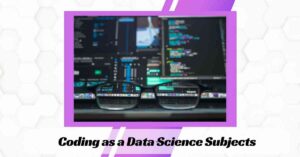
Coding is important in data science, as it is an essential tool for manipulating and visualizing data. With so many different coding languages available, deciding which one best suits your needs as a data science professional can be challenging. In this part, we’ll discuss the types of coding languages available, the benefits of coding for data science, and the different variables associated with this subject.
Regarding coding as a part of Data Science Subjects, Some of the most commonly used languages include Python, R, Java, and SQL. These languages have unique features and capabilities that make them well-suited for working with large datasets and creating powerful algorithms. Python is one of the most popular languages as it is easy to learn and use while still providing a wide range of functionality.
R is also popular as it offers more statistical functionality than Python and allows you to create detailed visualizations quickly and easily. Java is another popular language to use for data science due to its flexibility and scalability. Finally, SQL allows you to store large amounts of data in databases while allowing you to query them quickly and efficiently.
In addition to understanding the various coding languages available for data science projects, some benefits come from incorporating coding into your workflow. Coding allows you to automate tedious tasks such as cleaning up datasets or running complex analyses on large datasets. It also
helps streamline workflows by creating scripts that can be reused for multiple projects or analyses. Additionally, coding enables you to create interactive visualizations that can be used for presentations or reports on your findings. Finally, most programming languages have built-in libraries that provide functions and methods designed specifically for working with datasets.
Predictive Analysis
Predictive analytics is one of the most powerful Data Science Subjects available in today’s data science field, and you can say it is an integral part of the Data Science Subjects. It allows data scientists to analyze large amounts of data and identify patterns to help them accurately predict outcomes and make better decisions. Predictive analytics can identify potential risks, opportunities, and causes of events or outcomes.
So, how can you get started with predictive analytics? Becoming familiar with this field’s core concepts and topics is essential to begin learning predictive analytics. This includes understanding machine learning algorithms, big data analysis techniques, and data-driven modelling methods.
For freshers interested in learning predictive analytics, there are several Data Science Subjects that should be studied to gain an understanding of the topic. These include topics such as statistics for machine learning, Bayesian networks and graphical models, supervised learning algorithms and deep learning methods. Learning about data analysis techniques such as descriptive statistics and regression analysis is essential to understand how to prepare predictive models best.
On the other hand, if you are already a professional data scientist looking to expand your skillset into predictive analytics, several advanced Data Science subjects should also be studied. data science subjects, advanced topics such as time series analysis, reinforcement learning algorithms, natural language processing (NLP), and deep generative models can help predict future events or outcomes. Additionally, knowledge of artificial intelligence (AI) systems can be beneficial for building effective predictive models.
Overall, by understanding the various concepts associated with predictive analytics, you will become more well-equipped to tackle complex problems within the field of data science.
Data Science Subjects for freshers
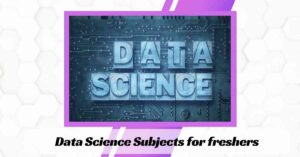
Data Science is a rapidly growing field requiring professionals to have diverse skills and knowledge. For individuals entering the world of Data Science, it is important to understand the Data Science Subjects and related topics required for success.
This part will discuss the essential Data Science Subjects for freshers and professionals alike. This is not an exhaustive list but rather a compilation of some of the most fundamental topics one should become familiar with if one wishes to pursue a career in Data Science.
First, let us consider the essential aspects of Data Science. Understanding basic concepts such as data collection, cleaning, exploration, visualization, and analysis is vital to becoming an influential data scientist. Additionally, knowing advanced Data Science Subjects such as predictive modelling, business intelligence, and optimization algorithm will provide an edge over other applicants vying for positions in Data Science.
Second, it is necessary to develop familiarity with these Data Science Subjects that is, mathematics and statistics fundamentals such as probability theory, linear algebra, calculus and numerical methods. It is also essential to understand how these basics can be applied to real-world problems requiring data analytics solutions.
Third, knowledge in either Python or R programming languages will help immensely when starting as a data scientist. These two scripting languages are versatile tools many organisations use for tasks involving numerical computing, statistical graphics and machine learning applications. Aspiring data scientists should seek out programming tutorials or take online classes to gain fluency in either language.
Data Science Subjects for professionals
Data Science is an interdisciplinary field that covers a wide range of topics or Data Science Subjects. It combines computer science, mathematics and statistics elements to draw meaningful insights from data. As a professional looking to expand your skill set, certain Data Science subjects are essential for success.
First, it is important to have a strong understanding of the fundamentals of Data Science. This includes learning about basic terminology, algorithms and tools. Additionally, having a good grasp of Statistics will be beneficial as these skills are necessary for interpreting and analyzing data effectively.
In addition, mastering Machine Learning and Artificial Intelligence (AI) is a plus for any aspiring Data Scientist. Knowing how to use algorithms and programming languages like Python will enable you to create powerful models that can efficiently process large datasets in real-time. data science subjects, Furthermore, you should be familiar with Big Data tools such as Hadoop and Apache Spark in order to manage unique datasets effectively. As well as this, understanding how to design databases and store information will also be invaluable in data-driven applications.
Conclusion
Lastly, learning to visualize data accurately while interpreting the results is essential. Being able to present the findings in an effective manner through storytelling or dashboard-based visuals can help organizations make informed decisions quickly. Data Science Subjects, Finally, advanced statistical modelling techniques can be used for predictive analysis and forecasting, which help businesses better understand their current market trends by accurately predicting future outcomes based on historical data.
Understanding these various Data Science subjects is paramount for any aspiring professional looking to grow in their career and take advantage of big data opportunities today’s world has to offer! By knowing the fundamentals of statistics and machine learning/AI technologies.
Frequently Asked Questions
Is data science full of maths?
Data science jobs require a strong understanding of mathematics. This is because machine learning algorithms and analyzing data require math skills. Math is not the only thing you need to know to succeed in data science, but it is essential.
How many subjects are there in data science course?
The foundation of Data Science Subjects lies not just in one but various domains which are- Statistics, Mathematics, Computer Science, and Business. These are the four core subjects that form the base of Data Science. The various topics in the data science syllabus fall under these four subjects.
Is data science is a hard subject?
Data science is a difficult field. There are many reasons for this, but the most important one is that it requires a broad set of skills and knowledge. The core elements of data science are math, statistics, and computer science. The math side includes linear algebra, probability theory, and statistics theory.
Is 3 months enough for data science?
You might able to if you work harder, but it certainly takes more time than three months as advertised.” My advice is if you are not sure about your own skills, try to learn what kind of Data Scientist skills and prepare it even before you go to the Data Science Bootcamp.
How many hours is data science?
Full-time data scientists usually work the standard 40-hour Monday through Friday workweek. Most data scientists have “a good amount of autonomy” in their work, but too much independence may be detrimental to maintaining work/life balance for some employees.13-May-2022
How many hours study data science
While undergraduate and master’s courses in colleges and universities often taken 2-3 years to teach you all the above, many say you can learn them in about 6 months by dedicating around 6-7 hours every day.













